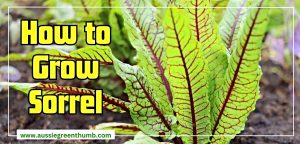There aren’t many plants that offer such dramatic flowers, with such attention, but camellias are definitely one of them. Growing your own camellia hedges offers a huge variety of creative design choices, but fundamentally, it provides a long flowering season, and dramatic waxy foliage all year round.
Keep reading for everything you need to know about growing camellia hedges, from choosing the right cultivar to planting it, and how to care for it for years, and years to come.
More...

Family: | Theaceae |
|---|---|
Genus: | Camellia |
Species: | Various |
Common Name: | Camellia |
Origin: | Southern Asia |
Location: | Outdoor |
Type: | Flowering shrubs or small trees |
Growth: | up to 20 m tall |
Sun requirements: | Light shade |
Foliage Colour: | Green |
Flower Colour: | Pink, white, or red |
Flowering: | Autumn to spring |
Edible Parts: | Edible flowers and dried leaves |
Maintenance level: | Medium |
Poisonous for pets: | Non-toxic to cats and dogs |
How to Start a Camellia Hedge
Camellia hedges are simple to start, and while they’re not the fastest-growing shrub in the garden, they are reliable. But first, you’ll need to choose the right type of camellia, as they are a varied genus, comprising dozens of species and hundreds of cultivars, each with its own unique attractions.
Perhaps the most attractive property of camellias is how well they respond to pruning, growing well from old wood, and even better when pruned regularly at their tips.
Choosing the Best Camellias for Hedging
Camellia sasanqua is the best-known camellia hedging species, but it will need controlling. Like any camellia it can easily reach a mature height of 5-6 m tall, and they really do make stunning shrubs as a result.
However, hedges are generally around 2-3 m tall, so those that respond best to regular pruning are the best choice. Camellia sasanqua, and its many cultivars are the best go-to group of camellias for hedging.
1. Camellia sasanqua
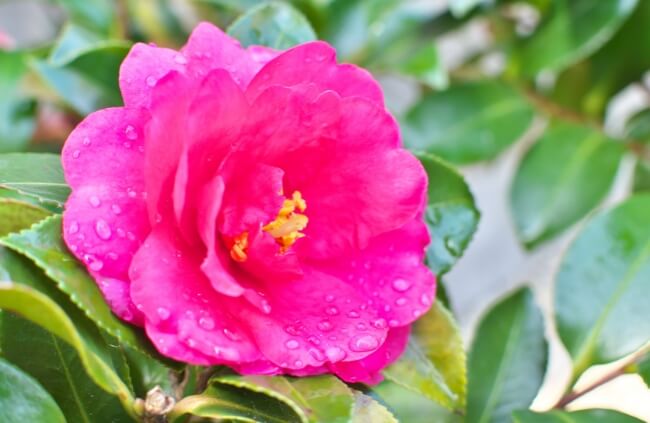
Camellia sasanqua is readily available in its natural red-flowering form, but is also the base for most dwarf cultivars, and most garden cultivars with open white flowers. C. sasanqua grows to around 3 m tall after a few years with no pruning, but will usually take longer with regular pruning.
Your patience and diligence will be rewarded with a much denser hedge, even if it does take slightly longer to establish.
Read our full guide to growing Camellia sasanqua for more comprehensive growing guides for this well-adapted cultivar.
2. Camellia ‘Plantation Pink’
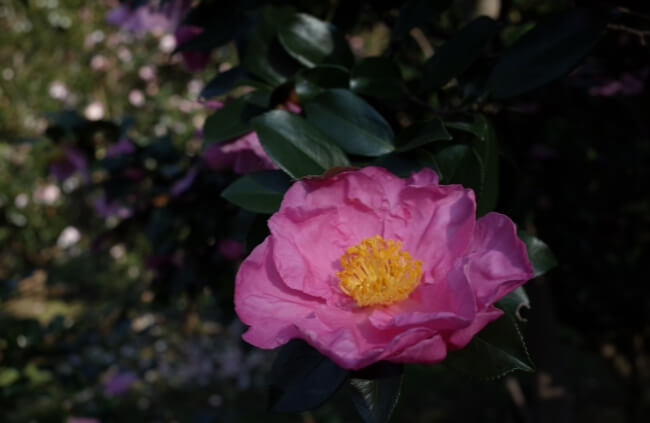
Camellia ‘Plantation Pink’ is a fast-growing camellia, reaching about 4 m tall after ten years, and will form a dense 2 m tall hedge with regular pruning after just five.
By placing Camellia ‘Plantation Pink’ quite close together (about 50 cm-1 m apart) you can quickly have the effect of a hedge, and they will happily grow into one another in time to create a dense boundary plant.
3. Camellia ‘Paradise’ cultivars
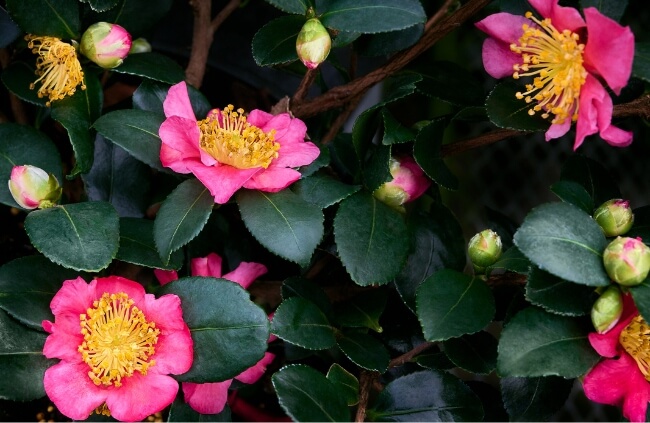
Camellia ‘Paradise Sylvia’ and Camellia ‘Paradise Little Liane’ are the most popular cultivars in the ‘Paradise’ series. All of which are reliably compact cultivars of C. sasanqua, growing to a maximum height of around 1 m tall, making them ideal for low-growing hedges, or even for border fronts to define the space between lawns and decorative planting.
4. Camellia japonica
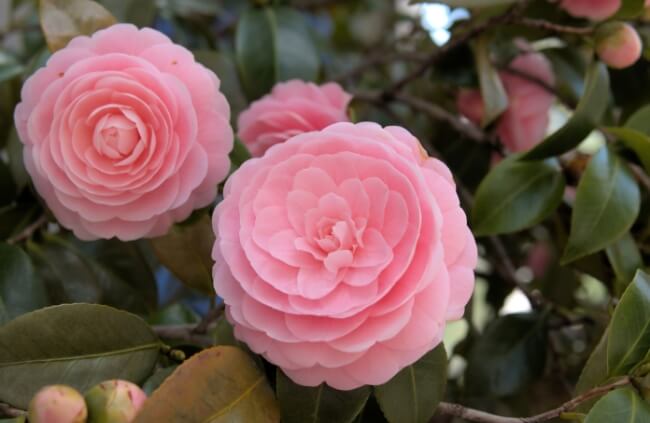
Camellia japonica, like C. sasanqua, makes great hedging plants. They respond well to pruning and flower reliably if properly fed. They are faster growing, and slightly hungrier though, so will require a lot of feeding, and slightly wider spacing (about 1 m apart when planting your hedge).
They can reach about 8-10 m tall if left to their own devices, so need regular pruning even once established to keep your hedges in check. The payoff for the hard work is usually tighter flowers, and C. japonica tends to have gorgeous double blooms on most cultivars.


Get Your Free Guide:
Master Growing Australian Natives eBook
A Must Have Complete Guide for Every Australian Garden
Get Your Free Guide:
Master Growing Australian Natives eBook
A Must Have Complete Guide for Every Australian Garden
Camellia japonica ‘Debutante’ is a particular favourite to plant as a hedge.
5. Camellia ‘Yuletide’
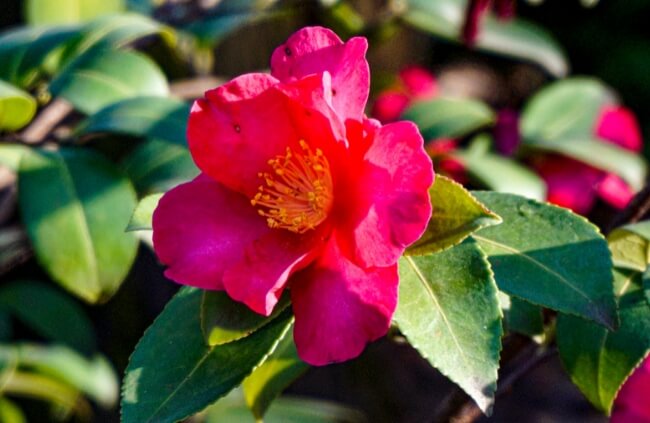
This winter flowering camellia flowers for a long while in the middle of the year when your garden is just starting to show hints of spring elsewhere. Its foliage is wonderfully dense, and each leaf is smaller than most cultivars.
Despite having single flowers, its centre is an open rich yellow, with more vigorous growth thanks to being a hybrid between C. japonica and C. sasanqua.
The most attractive property of Camellia ‘Yuletide’ is its self-limiting growth, which very rarely gets taller than 2.5 m. If you’re after a low-maintenance hedge, or a plant that you can forget about, this is it.
How to Grow a Camellia Hedge in Australia
First and foremost, it’s worth understanding that camellias, though native to South Asia, grow well here in Australia, and while the sight of tea plantations in full sun is evocative and well-known, it’s not necessarily the best way to grow them.
We’ve broken down some simple guides below to help you create the right light, soil, and moisture for new camellia hedges, but keep in mind that they will always flower better in slightly shaded positions, and produce more flavourful leaves in full sun.
For hedging, flowers are usually the main attraction, so they make the most sense in a garden that receives a fair amount of shade.
For more information on growing camellias as small trees and stand-alone shrubs, plus guidance on feeding, pruning, and propagating these wonderful flowering plants, check out our guide to growing camellias.
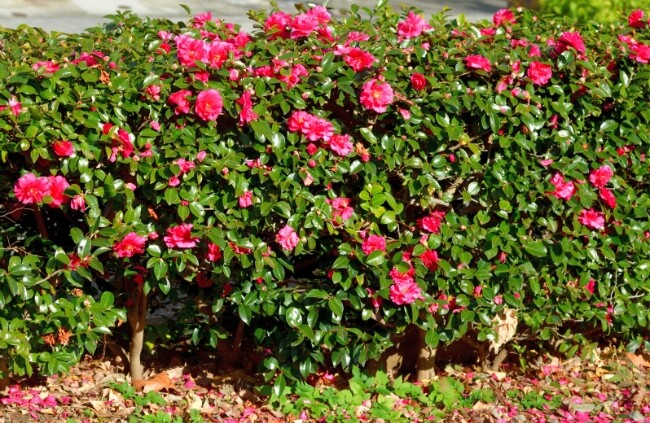
Where to Plant Your Camellia Hedge
Camellias grow best in part shade, but the purpose of hedging is to provide a garden border – the thing that generally provides shade, and takes the brunt of the sun. So, how do you plant a camellia hedge and keep it happy if you don’t have shade?
Well, the truth is, camellia will grow fine in full sun, it just won’t flower as well. If your house shades your front garden, or part of the back garden you can easily grow beautiful and bountiful flowering camellias.
If it’s not, they will flower for a slightly shorter window but still provide stunning, waxy, evergreen foliage.
Camellia Hedge Spacing
Camellias can be planted quite close together as young plants. Planting more tightly will limit the growth of each plant too. I’d personally suggest a spacing of about 50 cm between each camellia. This will limit them to a good-sized 2 m tall hedge with regular pruning, but it does also mean more regular watering.
To give them a less stressful start, plant them around 1 m apart, and prune them at the front and tops every few months for a few years to encourage a better shape.
Preparing the Soil for a Camellia Hedge
Camellias love acid soils. Anything with a pH of 5.5 to 6.0 will help to produce more flowers, and ensure that the essential nutrients are more accessible regardless of soil structure.
The soil itself doesn’t need to be incredible, but adding nutrients through fertilisers and mulches will help to prevent disease, and support more luscious growth as they are quite hungry plants.
Thankfully, this is quite simple to do. Provided you remember that camellias like acid soils, all you need to do is choose an acid plant fertiliser, or camellia fertiliser to feed it.
An annual mulch of part-rotted manure and regular application of used coffee grounds or tea bags to the soil around the base of your hedge will also help to keep the right pH balance.
How to Care for Your Camellia Hedge
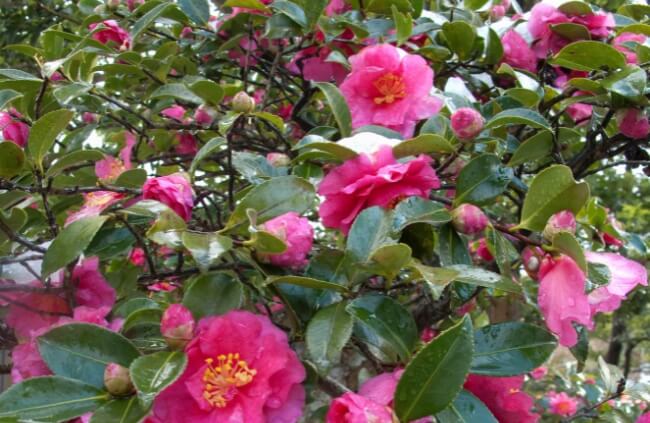
Feeding and Mulching a Camellia Hedge
Obviously, pruning is important for any hedge, and camellias are no different, but really, the most important thing to do with any camellia is to feed it. They are fine on most soils, and happy in most drainage conditions, but without adequate nutrients they struggle to hold buds, and can drop evergreen leaves, which take a full season to recover.
So feed, feed, feed. You can buy wonderful camellia fertilisers which are properly developed to include the essential nutrients, but a good low-maintenance alternative is to use part-rotted horse manure, which will help to retain acidity and provide all the nutrients they need.
Watering Your Camellia Hedge
Camellias are quite drought tolerant but can drop leaves and flowers if they have a dry spring. Water them well during flowering for a more vibrant hedge.
If you forget to water your camellia entirely, don’t worry. We’ve had one growing on what is best described as shale for the last thirty years, and it thrives. It’s rooted down to the water table, and while it flowers with limitation, it looks wonderful all year round.
Pruning a Camellia Hedge
The most important tip for pruning camellias is just that – tips. Camellias have quite large waxy leaves, so cutting with secateurs means slicing through leaves and opening them up to infection. It also produces unnatural-looking forms that take a while to bush back out.
Instead, prune camellias by pinching their growing tips from winter through to early spring, leaving any buds alone. Avoid pruning in summer and autumn while they are developing next year’s flowering buds.
Repeat this process annually for a denser shrub with more flowering buds.
Note: In cold parts of Australia, Camellias will lose their leaves in winter, but they are genetically evergreen. If they look healthy but drop leaves in cold winters, don’t worry – this is pretty normal.
However, if you’re after an evergreen hedge, maybe go for something native like Lilly Pilly if your winters get down to below freezing for more than a couple of days.
Problems and Pests with Camellia hedges
Camellias have plenty of chlorophyll in their waxy leaves, so do suffer from mealybugs and scale quite badly in dry conditions. If you notice these small white insects, scrape them off to prevent further damage being done, and leave the ground to dry out for a few weeks, which helps to break the larval life cycle.
Other than that, there aren’t many pests that will cause serious trouble for camellias in Australia. The more complicated things to consider are camellia diseases, which can cause ongoing problems which come back year after year.
Canker / Dieback
Camellias suffer from something called Camellia dieback, also called Camellia canker. It’s caused by a fungus called Glomerella cingulate, which causes cankered branches (tumour-like growths on branches) and black spots on leaves.
It spreads through contact, so can be stopped by cutting out the affected part of your hedge and burning it, before tidying up with disinfected tools.
Root rot
Root rot is a general term but the main cause is Phytophthora cinnamomi. Initial signs are leaf yellow in patches, which wilt and then drop. If you notice these early signs in time, letting the soil dry out can often be enough to fix it before it really takes hold.
Once root rot has completely set in, the only option is containment. Remove the affected plant and its roots, change the soil in that patch, and allow healthy camellias to fill out the gaps.
Flower blight
Camellia flower blight is easily noticeable by brown patches on open flowers and buds. It’s a common fungal problem with camellias, worsened by excess humidity, and directly exacerbated by watering the foliage and buds at any time of year.
Avoid flower blight on camellias by never watering the plant, but always directly at its base. Remove affected flowers and dispose of them without composting.
Frequently Asked Questions About Camellia Hedges

Are camellias fast-growing?
Camellias have a moderate growth rate, and will rarely grow more than 10 cm per year once established. While young plants develop they can grow up to 30 cm a year, but this should be pruned out to create a denser hedge or shrub.
What is the best time to plant camellias?
Plant camellias in mid-autumn if you can when the temperatures are slightly cooler, so they have less stress on top growth while they develop roots. Planting in late winter or spring is fine too. Avoid summer planting camellias.
Are camellias high maintenance?
Camellias are not high-maintenance plants at all. They require very little care, and infrequent but considered pruning.
Can camellias survive cold winters?
Camellias will survive freezing temperatures, even down to -12°C. They are very hardy plants but will lose foliage that would otherwise be evergreen in prolonged cold snaps.
How do you use camellias’ leaves?
Camellia sinensis hedges can be used to harvest your own tea, as can most other species, but it is sinensis that offers the best flavour and most reliable new green leaves in spring.
Pinching young leaves regularly will provide a good supply of leaves for drying, and help to thicken out the plant.
Wrapping Up Our Camellia Hedge Guide
There are so many plants to choose from when deciding on your hedge, but camellia is definitely one of my favourites. Not only is it beautiful, but in most Australian gardens, the young growth or several cultivars can be used to make beautiful tea.
If you’re still undecided, check out our top tips for choosing the best hedging plants in Australia. If you’ve decided on camellia, I commend your choice, and now you know how to grow camellia hedges in Australia there’s nothing stopping you.
Published on August 26, 2023 by Maisie Blevins
Last Updated on March 27, 2024




